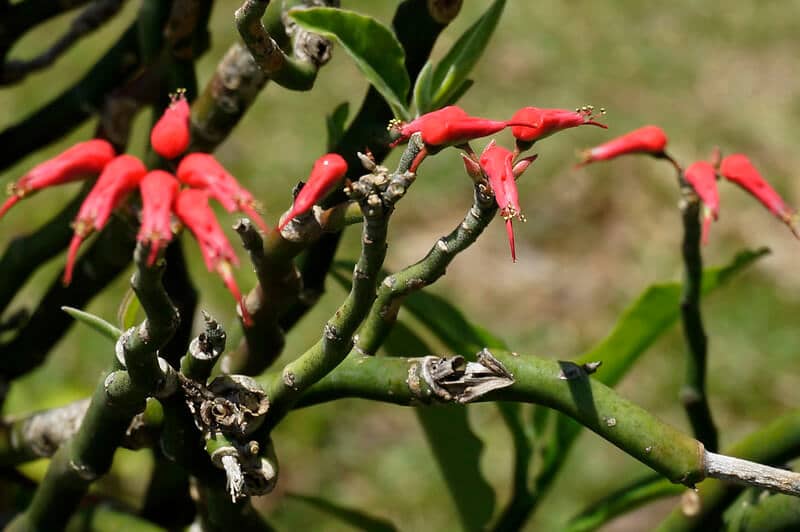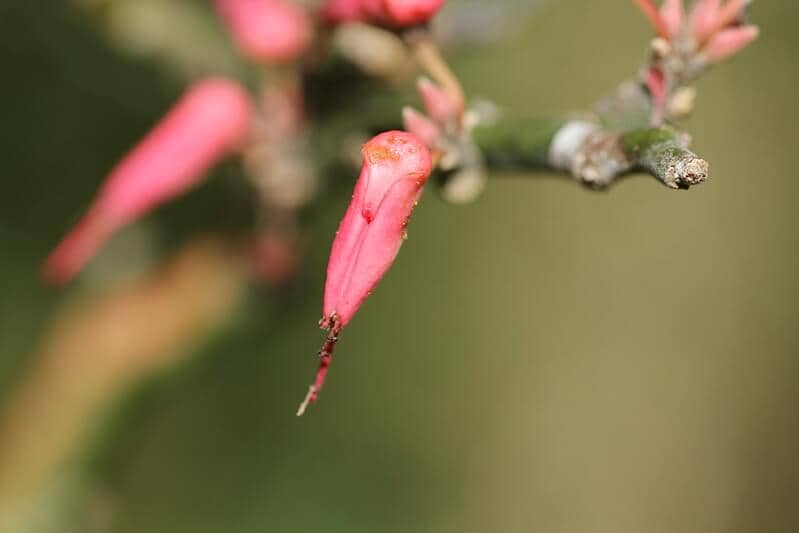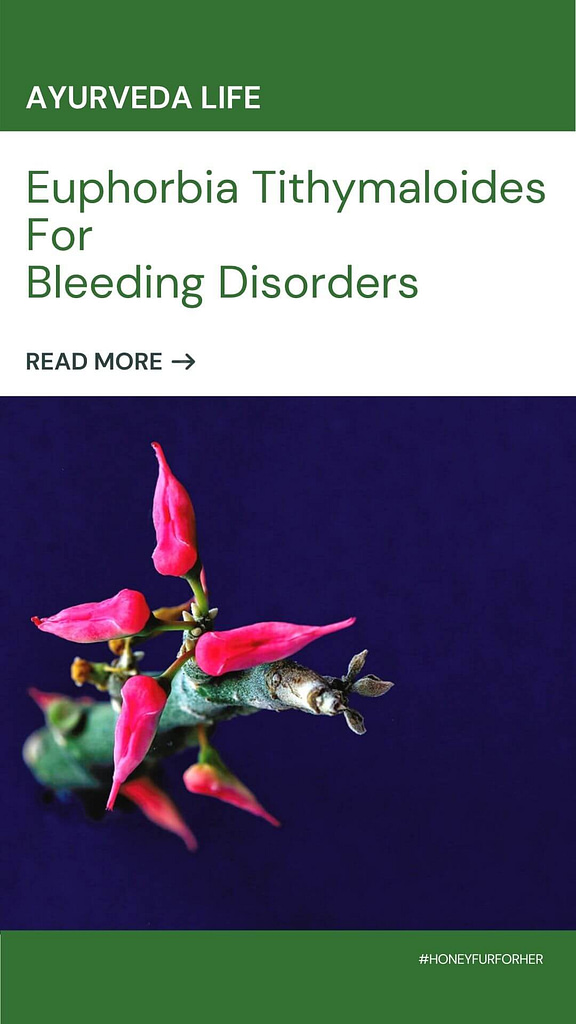If there is one thing the medical world might be doing wrong, it is definitely underrating the power and untapped potential of Ayurveda. Plants have always held a superior position when it comes to healing and medicinal properties. Delving deeper into the plant world, one can find superheroes in the form of herbs and plants that possess immense power and value. Amongst these green super plants, one of them stands out very well.
Naagdon, scientifically known as Euphorbia Tithymaloides, is a medicinal herb that is commonly found in nature and can be extensively used for a whole array of symptoms and illnesses.
Nagdon plant is extensively used to treat piles, excessive bleeding, constipation, joint pain and all sorts of bleeding disorders.

Bio & Properties
Although native to tropical and subtropical North America and Central America, the herb is very commonly found in all areas and can be easily located in gardens and parks in a collection of shrubs or hedges. Naagdon, or Nagdon, is more commonly known as Devil’s Backbone around the world and is also used as a decorative plant. A fun little trivia fact; Naagdon is also informally called Christmas candle, buck-thorn, redbird cactus and more. Pretty exciting bio for a common garden herb. Lastly, if the names still don’t ring a bell, they are also known as airi, baire, and agia in India.
The stem, often resembling a cane structure, sometimes looks like a miniature bamboo plant. But what sets it apart from other botanically related plants is that it is arguably the only plant which produces non-toxic latex, when extracted correctly. Naagdon propagates through stem cutting and seeding, hence the bamboo-like structure.
The leaves are smooth and elliptical and the plant bears flowers which are void of any scent. Even though no distinct scent can be traced to a Naagdon plant, one way to identify it is by observing the humming birds or cabbage worms in the vicinity, both highly attracted to this particular herb. The plant leaves are bitter in taste and are on the thicker side while being foot shaped.
NAGDON PLANT USES AND REMEDIES
Naagdon is a boon when it comes to treating bowel related issues, specifically to stop abnormal bleeding from any body part such as in piles, periods, colitis, etc. Not limited to these, its uses also extend to treating joints and wounds. Naagdon root is known to be a powerful emetic and is frequently used to induce vomiting as well.
Not just that, the plant is highly versatile in terms of medicinal properties such that every single part of it can be used for multiple cures. Also, most illnesses follow a general consensus for treatment using Naagdon. The variation is very little and often only about change in form or dosage amount. Following are the prescribed dosages and methods that can be used to treat the particular diseases:
PILES
Commonly known as Bawaseer in India, Naagdon helps in treating bleeding piles and infection, especially helping stop the blood flow to speed up recovery. To treat bleeding piles, drink Naagdon decoction in the morning on an empty stomach.
INTESTINAL WORMS
The latex extracted from Naagdon has been shown in experiments to be effective against intestinal worms and to reduce inflammation when ingested. This herb is widely used in major Ayurvedic medicines when it comes to treating intestinal syndromes.
Take Naagdon-Dudhi juice and drink it daily or as advised by your Ayurvedic practitioner to cure the infection.
DIABETES
Not just intestines, Naagdon plant’s latex is also capable of combating diabetes mellitus, commonly known as diabetes. Further research is being conducted to bring better and faster cure results using this medication.

RESPIRATORY AILMENTS
Nagdon leaves have been used to treat asthma, persistent coughing, laryngitis, mouth ulcers, and even venereal disease. The leaves are normally consumed as is or turned to some other forms.
Drink Naagdon tea as advised by a practitioner for best results.
SKIN DISEASES
The latex has been used topically to treat calluses, ear ache, insect stings, ringworm, skin cancer, toothache, umbilical hernias, and warts, although some remedies are yet to be scientifically proved effective. Despite the lack of scientific evidence, the treatments do help to quite an extent when coupled with a prescribed treatment course. Latex can be applied or spread on the affected area to help with the treatment.
BOWEL ILLNESS
Due to Naagdon possessing euphorbol, it acts as a powerful emetic. An emetic is a compound that can cause expulsion of one’s stomach contents through mouth or nose, i.e. vomiting. A few drops of the latex are added to milk and used as an emetic for treating stomach related illnesses.
HEAVY PERIODS
Heavy periods (menorrhagia), over bleeding in periods, and to some extent, cramps and potential infections, can be greatly relieved using Naagdon. Consume a Naagdon powder recipe daily in the morning on an empty stomach. It is advisable to confirm the dosage amount with a medical professional first.
JOINT PAIN
Joint Inflammation is a very common occurrence and can often last for long periods of time. Using Naagdon in desired method and form, it can be used to treat joint pain and inflammation. Apply Naagdon paste on the affected areas like a balm or lotion. Repeat as per amount of discomfort felt during the day.
CONSTIPATION
From acute to chronic constipation, Naagdon is an effective medicine regulating one’s bowel. Additionally, the plant has also been observed to be useful to treat diarrhea as well. Standalone Naagdon leaves are consumed here, their juice raw juice being super effective. Chew on Naagdon leaves daily to cure constipation.
ULCERATIVE COLITIS
A severe large intestine disease, it is a chronic inflammatory condition often accompanied by ulcers and sores and even weight loss in the long run. Naagdon has been proven to be a powerful remedy to cure Ulcerative Colitis. Take a basic Naagdon juice and drink daily in the morning on an empty stomach.
AMEBIASIS, INTESTINAL INFECTION
A parasitic infection of the colon, Amebiasis is a rare but serious disease. It can further cause intestinal and digestive tract infections. Naagdon helps resolve the symptoms quickly.
ABDOMINAL PAIN
From cramps to ulcers to irritated mucous lining. Even gas or bleeding due to any reason can be treated using the herb. For bowel related issues, including gas or bowel ulcers/bleeding, chew on 3 Naagdon leaves every morning.
URINARY AILMENTS
Many urinary issues such as scanty urination, burning sensation during urination, painful urination, etc. can be adequately resolved with the help of the plant. Drink Naagdon sharbat twice daily for best results.
BOILS AND WOUNDS
Another interesting fact about Naagdon is that it can be used topically too. When suffering from boils or dealing with small or shallow wounds, the herb can be used to relieve the pain and also accelerate healing.
METHODS OF USE & DOSAGE INFORMATION
Naagdon can be used and consumed in many ways depending on the problem to be cured. It is very versatile, as mentioned previously, and can be consumed in solid and liquid form. The major parts used for medicine are the leaves and the roots. Some common and effective methods are as follows:
Naagdon Powder:
The powder is created by grinding around 1-3 leaves of Naagdon with 3 balls of black pepper. Although being a generic recipe, it can be used for most treatments and modified if needed for specific or prescribed dosages. Naagdon powder is mainly used to help with heavy periods.
Naagdon Decoction:
This is a mild decoction and can be used as a powder for water or as a thick paste. Take around 1-3 Naagdon leaves and wash them to remove any dirt. Then, grind the leaves with black pepper (2-3) using a mortar and pestle. Add the resulting powdered mixture in water. This decoction is very useful in treating bleeding piles (bawaseer)
Naagdon Paste:
This is a topical application method. For this, warm Naagdon and castor leaves and crush them. Lastly, add til taila (sesame oil) to the crushed mixture. The resulting paste can be used as a balm for the joints. Best used for joint pain and inflammation.
Naagdon Leaves:
The most basic method and equally as effective as the other forms. Naagdon leaves can be eaten/consumed as is. This form is mainly used to help with constipation.
Naagdon Juice:
There are multiple combinations possible. One is by extracting the juice of Naagdon leaves and mixing in water. Another is by mixing Naagdon leaves (3) juice with Dudhi (bottle gourd) grass juice. Also possible is a sharbat (squash) of Naagdon leaves in water, adding honey or sugar to it.
Naagdon Tea:
The tea can be brewed from the root as well as the leaves. The method of drying them and then brewing it (like normal green tea) applies here.
Naagdon Latex:
Latex is specially prepared by extracting it from the plant using fixed processes. Naagdon latex is rarely self-made due to potential carcinogens. Hence, it is best advised to procure the latex from an Ayurvedic store.
SIDE-EFFECTS AND SAFETY
Although it is virtually safe and reports no side effects, the reaction to Naagdon herb may vary from person to person based on their body’s ability to handle it. Naagdon is a natural herb medicine. Even then, it is recommended that a doctor or a certified Ayurvedic practitioner be consulted before consumption or usage.
Due to the abundance of it in the surroundings and fairly easy procedures to self-medicate, it is highly ambiguous to continue to do so without any supervision. A full analysis is suggested with a proper diagnosis of symptoms, medical history and interaction with drugs for those that choose to use Naagdon or its derivatives.
Did you find this post useful? Would you like to get back to it later? Save THIS PIN below to your Pinterest Natural Living or Ayurveda board!


mam plz tell me the family name of Euphorbia tithymaloides
Hi Dr. Verma,
The family name is Euphorbiaceae.
Regards,
Swati
How to take nagdon I have piles
Mam,I am suffering from fistula.How can naagdon be beneficial to me.